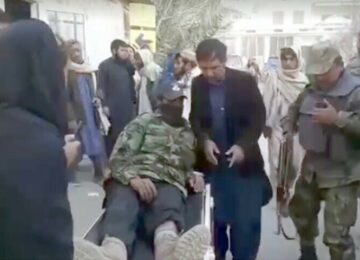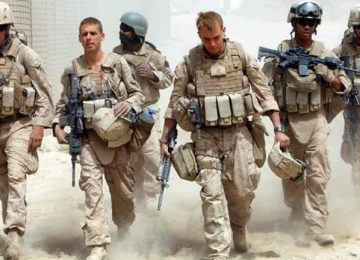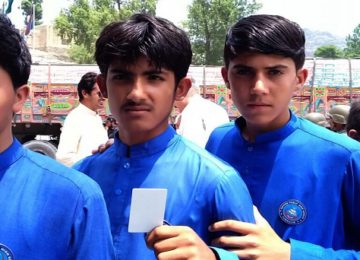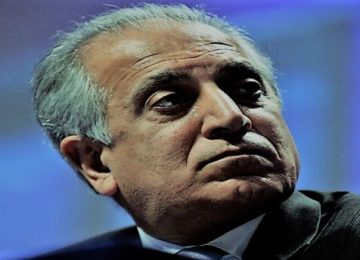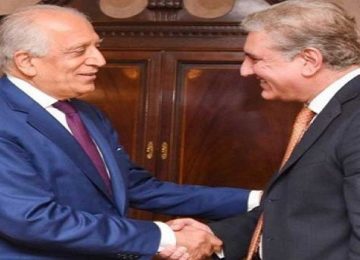Afghans may, just possibly, have a happier Eid than in previous years. The government, the Taleban and the United States military have all called temporary ceasefires. Meanwhile, seven marchers for peace, who set off from Helmand on 13 May have been walking towards Kabul in temperatures of more than 40 degrees while keeping the Ramadan fast. Their demand for a ceasefire during Ramadan was not met, but as AAN’s Ali Mohammad Sabawoon reports (with input from Kate Clark), their arrival in Kabul will coincide with the Eid ceasefire.
First came President Ashraf Ghani’s 7 June announcement that government forces would not launch any offensive attacks against the Taleban during the last days of Ramadan, from Lailat ul-Qadr, when Muslims believe the Quran was first revealed, to the fifth day of Eid. His announcement came in a series of tweets that referred back to a meeting of ulema in the capital on 4 June, who declared the Taleban’s fight “had no root in Shari’a law.” They called on the government and the Taleban and other insurgent groups to call a ceasefire and urged the Taleban to join the government in talks. (1)
Ghani’s announcement was soon followed by the commander of US and NATO forces, Commander John Nicholson, saying the forces under his command would “honour” the government’s ceasefire.
Then, on 9 June, the Taleban followed suit: “during Eid days,” they would “suspend their attacks against the insider enemy.” The Taleban also announced that all detainees who guaranteed not to fight against them would be freed to mark the holiday.
The Islamic State of Khorasan Province (ISKP), the Daesh offshoot in Afghanistan, has made no comment on the ceasefires or said what it would be doing.
The government and US military ceasefires will not apply to ISKP and the Taleban said its attacks against foreign forces would continue. Nevertheless, this ceasefire is unprecedented. Afghanistan has not seen such a ceasefire since the outbreak of the post-2001 insurgency.
The conflict does usually quieten down during Ramadan and particularly during both Eid holidays, but there have been some particularly nasty attacks during previous years when Afghans were marking Eid. In 2012, for example, a 15-year old boy blew himself up as worshippers gathered for Eid ul-Adha prayers in Maimana City, targeting the Faryab Provincial Governor. They boy killed 40 civilians, including six children, and injuring 59. The following year, the governor of Logar, Arsallah Jamal, was killed as he delivered a speech for Eid in the main mosque in Pul-e Alam; the bomb had been hidden in the microphone. So blood can and has been shed during Eid and even in mosques. This year, if all goes well, there will be a silencing of the guns and a breathing space for Afghanistan’s people.
Marching for peace
One of the seven Helmand peace marchers, Bacha Khan Mawladad another organizer of the march who is a youth activist, told AAN they were very happy when they heard that both the government and Taleban made their announcements. “A single bullet,” he said, “can take the life of a human being – that’s why we welcome the ceasefire.” He said it was the first of their demands to be met – despite it only being a temporary ceasefire – but as it had not come in response to their protest, they had decided to carry on marching.
The protesters started their demonstrations demanding peace after a suicide car bomb detonated outside near the door of a stadium in Lashkargah city in Helmand province on 26 March: more than a dozen civilians were killed (AAN’s earlier analysis). Those who had lost family members in the attack were among the demonstrators. “Our tears have not yet dried,” one told AAN. Obaidullah, from Nawzad district had lost two nephews and saw four other family members injured in the stadium attack. “We want the Taleban and the government to stop killing innocent people,” (see here.)
The demonstrators pitched tents in the provincial capital and held a hunger strike, which resulted in some participants being hospitalised. Demonstrators said they would march to the Taleban stronghold of Musa Qala district to meet insurgent commanders but cancelled their plans after the Taleban warned them not to visit. On 9 May, the protestors held a meeting with religious scholars, tribal elders and youth and presented a four demands asking the parties for a ceasefire in the coming month.
1. Respecting the holy month of Ramadan, all sides of war should declare a ceasefire.
2. Specific channels and addresses for peace talks should be identified among all sides of the war, and peace negotiations should be launched.
3. Considering Islamic and national values and interests, practical steps should be taken for forming a system that is acceptable to all sides.
4. Based upon the agreement of all sides in this war, a specific timeline should be set for the withdrawal of international forces from Afghanistan.
Both Taleban and government, we reported, appeared wrong-footed by the protests, unsure how to respond. No ceasefire occurred. Instead, the annual onset of the summer fighting season brought a sharp increase in violence across the country. One count of incidents by Pajhwok Afghan News estimated about 3,000 people were killed and injured in the month of May, a 42 per cent increase from the previous month. As usual, Helmand ranked among the most violent provinces. Adding to the intensity of this year’s battles there has been the recent US deployment of High Mobility Artillery Rocket System (HIMARS) truck-mounted multiple rocket launchers. The Taleban launched attacks on several district and provincial capitals, including Farah (see AAN reporting here and here and Ghazni, including on Andar (see AAN reporting here).
As violence intensified, the Helmand demonstrators decided to try a different approach. Youth activist and former journalist Eqbal Khaibar told AAN on 13 May: “When our declaration was not listened to by either warring party and they did not offer any response, we decided to start a long march from Helmand to Kabul.” They began marching on 13 May. (2)
Temperatures climb above 40 Celsius in the southern provinces in June, and Highway 1, that snakes northwards to the capital, offers almost no shade from an unremitting sun. Nevertheless, marchers have observed the Ramadan fast, abstaining from water from dawn till dusk. They say they are undertaking this punishing ordeal as a way to make plain the thirst of Afghan citizens for peace. They have also faced the insecurity that Highway 1 has become infamous for, not just the risk of insurgent attack, but also highway robbery.
Warring sides reluctant to stop the fighting?
The government has been, at best, lukewarm in its response to the marchers. Deputy presidential spokesperson Durani Waziri told AAN that, generally speaking, the Afghan government supports any kind of step taken for the sake of peace but it “has yet to reflect on this particular group.” She said they would prepare a response by the time the group arrives in Kabul. Spokesman for the High Peace Council Ihsanullah Tahiri did praise the marchers to AAN, but mentioned the Taleban alone as needing to respond; he said the council hoped they would “welcome the voice of peace and declare their readiness for peace talks.”
Peace marcher Khaiber was scathing about the government’s stance: “[It] has no determination when it comes to peace,” he told AAN. He accused the government of merely making “peace propaganda” in the media, while actually making hurdles for the marchers. He believed that certain posts on social media hostile to the marchers – for example claims that they were funded by ‘the Americans’ – which undermined their security had come from people linked to the local office of the High Peace Council and (un-named) Helmand-based politicians. However, he had scant evidence for this stance and it was denied by the High Peace Council nationally. “We complained to Helmand security department to arrest these people,” Khaibar said. “The security department called them and told them to delete their posts. They did delete them, but have not been arrested.”
As for the Taleban, Khaibar pointed to what he said was a false statement on 20 May from the Taleban spokesman that American money had paid for the protester’s tents. Zabiullah Mujahid, a Taleban spokesman, again appeared to threaten the marchers in this written response to a question from AAN: (3)
If these activists do these actions from the deepest part of their hearts, they should go to the American bases [and demand] they end their invasion and pave the way for a real peace. If they only ask us for a ceasefire while the invaders remain in their positions, then the protestors are examples of [General] Nicolson’s remarks. He said last month that they would pressurize the Taleban on military, social, political and religious bases. Unfortunately, we see that planned pressure… As we have destroyed their conspiracies for 17 long years, we will disable their current weapons as well.
The accusation was clear: the marchers were merely tools of the Americans. There is also the implied warning that the Taleban will ‘disable’ them. The Taleban accusation of US backing, Khaibar said, had hurt their campaign in Taleban-controlled areas. Nevertheless, despite the accusations and the implied threats, they had kept on marching and, the marchers said, found support from ordinary Afghans, not only civilians but also Taleban.
Solidarity from ordinary Afghans—including some Taleban fighters
The marchers told AAN the response they had had from ‘the street’ had been very different from either of the warring parties. Religious leaders and tribal elders had praised them for their efforts, and people who live along the highway had opened their homes to them, giving them food and shelter. They had had some hostile reactions, they said. For example, in the Khirqa Mosque in Kandahar, a man had grabbed the microphone, interrupting the meeting to say peace would never happen. However, the response had in general been overwhelmingly positive. That included, on their way through Zabul, Khaibar said, a group of armed Taleban fighters coming to meet and welcome them.
They said they were local Taleban and tired of war.” We accepted the risk of death,” they said “knowing the government forces might attack us [if we came to meet you]. We just came to convey our message. We support you! You go ahead! We do not know who we are fighting with and for. Somebody commands us by walkie-talkie, and we do not know who he is. Sometimes, we are told to go ahead and fight and then we are told to retreat for no [apparent] reason.
The number of marchers has swelled a little along the way. They now include a congenitally blind young man who joined in Zabul. An old woman whose three sons had been killed in the conflict, reported Afghan media, had also wanted to join the marchers, but they encouraged her to pray at home instead of making the arduous journey. They are understood to have reached Qarabagh district of Ghazni province with 37 marchers and arrived in Ghazni city with nearly 60. “The women and men of Ghazni city welcomed us,” he said, telling AAN that they planned to stay there for two more days to talk to different people and will set off Kabul on 11 June. Ghazni-based journalist, Habib al-Rahman Tasir described to AAN how two teams of girls and boys from Nawabad school of Ghazni had come to welcome the marchers by singing anthems of peace. Tasir said majority of boys and girls who sung the peace anthem were Hazara The march organizers said that large numbers of youths from Ghazni and Wardak provinces had also registered their names to join the march, promising to join as it approached the capital.
A dangerous journey
Three of the marchers were hospitalized for two days with exhaustion in Zabul. Doctors urged them to rest, but they carried on. As well as the onslaught on the body they have endured, they have also been shot at and threatened. When they reached the Greshk crossroads in Kandahar and turned toward a village at night, for example, police started shooting at them. When they asked the villagers why, the villagers explained that the marchers had been carrying a lamp, something banned by the police in that village so as to differentiate civilians from insurgents (who do carry lights). On another occasion, the marchers were travelling at night from Daman district to Shahr-e Safa, still in Kandahar, when all of a sudden some people shouted at them and told them to stop and take everything out of their pockets. After hearing about the peace march, however, the villagers apologized for bothering them. The marchers had not informed security officials about their route, but said that after this incident, they had decided to keep the police in the picture about their movements.
Peace to survive and fighting for no outcome
The Helmand marchers have accepted great risks on their path to peace. As they approach Kabul, they have said they will not meet government officials in Kabul, but will keep their protest alive by meeting ulema, young people and tribal elders in the mosques. They insist they want a public presentation of their demands to both the sides in conflict. Mawladad told AAN that the parties to the dispute already know about the declaration. So while the ceasefire is welcome, there are still three other demands from the marchers: talks, forming a ‘system’ acceptable to all and a timetable for foreign troop withdrawal. He said that if their four demands were not met, they would extend the march to other provinces and continue around Highway 1, which rings the country, returning back eventually to Helmand. “We will never give up,” he said.
The marchers have not reached a critical mass where numbers could force action from one or both of the warring parties. Still, the fact that their arrival in the capital is coinciding with the first ceasefire of the post-2001 insurgency feels symbolic. What happens after Eid is another matter. Will Afghans wake up to renewed bloodshed or is there any possibility for this ceasefire – so sweet, but so short – to be extended?
Edited by Graeme Smith, Sari Kouvo and Kate Clark
(1) Ashraf Ghani announced the ceasefire in Dari and Pashto – available here and in a series of tweet:
The Government of the Islamic Republic of Afghanistan announces ceasefire from the 27th of Ramadan until the fifth day of Eid-ul-Fitr following the historic ruling [Fatwa] of the Afghan Ulema.
The Fatwa declared that violence and suicide attacks are not only against Islam but also strictly forbidden in our religion. We also welcome the unprecedented fatwa that only the state can declare jihad thereby rendering violent campaign by any group anything but a holy war.
#Afghan national defense and security forces will only stop offensive manoeuvres against Afghan armed Taliban and will continue to target Daesh and other foreign backed terrorist organizations and their affiliates.
This ceasefire is an opportunity for Taliban to introspect that their violent campaign is not wining them hearts and minds but further alienating the #Afghan people from their cause.
With the ceasefire announcement we epitomize the strength of the Afghan government and the will of the people for a peaceful resolution to the Afghan conflict.
(2) The group initially consisted of the core organizers of the Helmand peace movement: Eqbal Khaibar, Bacha Khan Mawladad, Abdul Malik Hamdard, Sardar Muhammad Sarwari, Abdul Salam Bayan and Bahlol Patyal. Khaibar said when they reached Kandahar eight other youths joined them, including Zmary Zaland, the champion body builder.
(3) An earlier statement by the Taleban on 28 March said the protestors “should go to Shurab and Kandahar airbases of [the] American forces and ask them for peace instead coming to Musa Qala.” The statement warned against protestors visiting Taleban areas because international forces or intelligence services might take advantage of the situation “and something might happen to you.”
By Special Arrangement with AAN. Original link.
Disclaimer: Views expressed on this blog are not necessarily endorsed or supported by the Center for Research and Security Studies, Islamabad.




